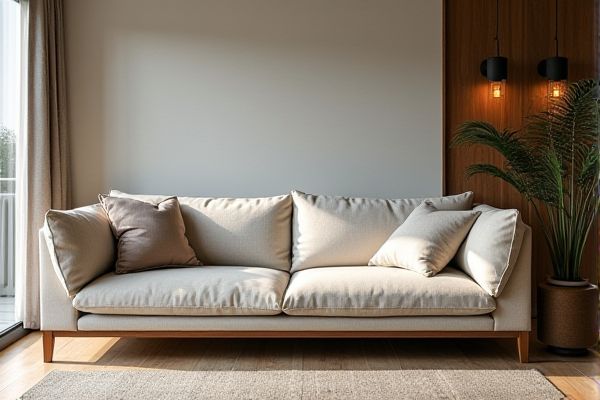
Weatherproof sofas are designed to withstand exposure to various outdoor elements like sun, rain, and wind, ensuring durability and comfort over time. Understanding the differences between weatherproof and waterproof sofas can help you choose the best option for Your outdoor space--explore the rest of the article to learn more.
Table of Comparison
| Feature | Weatherproof Sofa | Waterproof Sofa |
|---|---|---|
| Definition | Designed to resist various weather conditions including sun, rain, and humidity. | Specifically designed to prevent water penetration and repel liquids. |
| Material | Uses UV-resistant fabrics, rust-proof frames, and quick-dry foam. | Features waterproof covers such as vinyl, coated polyester, or laminated fabrics. |
| Usage | Ideal for outdoor areas exposed to sun, wind, and occasional rain. | Best for areas prone to frequent spills or heavy moisture exposure. |
| Durability | Long-lasting against fading, mildew, and weather damage. | Resists water damage but may vary in UV or chemical resistance. |
| Maintenance | Requires regular cleaning; cushions may need to be dried after rain. | Easy to wipe clean; cushions often fully water-resistant or removable. |
| Price Range | Generally mid to high, reflecting multi-weather resistance. | Varies from low to mid, focused on water resistance only. |
Weatherproof vs Waterproof Sofas: Key Differences
Weatherproof sofas are designed to withstand various outdoor elements such as UV rays, rain, and temperature fluctuations, using materials like solution-dyed acrylic or olefin fabrics that resist fading and mildew. Waterproof sofas feature materials or coatings that prevent water penetration entirely, such as vinyl or polyurethane-treated fabrics, making them ideal for direct exposure to moisture without absorption. The primary difference lies in weatherproof sofas offering broader environmental resistance including sunlight and temperature changes, while waterproof sofas specialize in complete water impermeability.
Materials Used in Weatherproof and Waterproof Sofas
Weatherproof sofas typically use materials such as solution-dyed acrylic or polyester fabrics combined with UV-resistant coatings to withstand sun exposure, moisture, and mildew. Waterproof sofas incorporate impermeable barriers like vinyl or specially treated polyurethane covers that prevent any liquid penetration, ensuring no water seeps through the fabric. Both types often feature rust-resistant aluminum or synthetic frames to enhance durability against outdoor elements.
Construction and Design Features
Weatherproof sofas are constructed using materials like durable synthetic fibers and UV-resistant coatings that withstand sun exposure and temperature fluctuations, while waterproof sofas feature specialized treatments or membranes that repel liquid penetration, preventing water damage and stains. Both designs incorporate robust frameworks made from rust-resistant metals or treated wood to enhance longevity in outdoor environments. Your choice depends on whether you need fabric that resists environmental wear or prioritizes impermeability against moisture.
Durability and Longevity Comparison
Weatherproof sofas are designed to withstand various outdoor elements such as UV rays, rain, and temperature fluctuations, providing enhanced durability and longer lifespan in variable climates. Waterproof sofas feature materials that prevent water penetration, protecting the cushions and frame from moisture damage but may not always resist sun fading or temperature extremes as effectively. Choosing a weatherproof sofa enhances overall longevity by combining water resistance with robust material performance against all weather conditions.
Maintenance and Cleaning Requirements
Weatherproof sofas typically require regular cleaning to prevent mold and mildew caused by exposure to rain and humidity, often needing water-repellent treatments to maintain durability. Waterproof sofas are designed with non-porous materials that resist liquid absorption, making them easier to clean and maintain with just a wipe of a damp cloth. Choosing a waterproof sofa reduces the need for intensive maintenance, while weatherproof options demand more frequent care to preserve fabric integrity under varying weather conditions.
Comfort and Aesthetic Appeal
Weatherproof sofas offer superior comfort through breathable, moisture-resistant materials that maintain a pleasant seating experience even in varying outdoor conditions. Waterproof sofas prioritize protection from water damage using coated fabrics or synthetic materials, which may sacrifice some softness for durability. Choosing Your sofa depends on whether you value comfort and style versatility in changing weather or maximum protection against spills and rain.
Ideal Placement: Indoor vs Outdoor Use
Weatherproof sofas are designed with materials that resist typical outdoor elements like rain, sun, and humidity, making them ideal for patios, decks, and garden seating areas. Waterproof sofas feature a protective coating that prevents water penetration, suitable for both indoor spaces like kitchens or sunrooms and outdoor areas exposed to direct rainfall. Choosing between the two depends on placement needs: weatherproof for general outdoor durability and waterproof for environments where water exposure is frequent and direct.
Price and Value Considerations
Weatherproof sofas typically have a higher upfront cost due to durable materials like synthetic wicker and UV-resistant fabrics, offering long-term value through resistance to fading, mildew, and moderate moisture. Waterproof sofas often use coated fabrics or vinyl, providing excellent protection against spills and heavy rain at a generally lower price point but may compromise breathability and comfort. Evaluating price versus value involves considering climate exposure, maintenance requirements, and the sofa's intended outdoor use to determine the best investment.
Pros and Cons of Weatherproof Sofas
Weatherproof sofas offer durability against various outdoor elements such as rain, sun, and humidity, making them ideal for patios and gardens due to materials like treated wood, metal, and weather-resistant fabrics. Their main advantage is resistance to fading, mold, and mild moisture exposure, but they may not withstand prolonged submersion or heavy downpours as effectively as waterproof sofas. However, weatherproof sofas generally require less maintenance than indoor furniture but still need occasional cleaning and protective covers for longevity.
Pros and Cons of Waterproof Sofas
Waterproof sofas offer superior protection against spills, stains, and moisture, making them ideal for outdoor use or homes with pets and children. Their materials, such as vinyl or treated leather, resist liquid penetration but can sometimes compromise breathability and comfort. However, these sofas may be prone to cracking or peeling over time if not properly maintained, limiting their durability in comparison to weatherproof options designed to withstand UV rays and varying temperatures.
 homyna.com
homyna.com